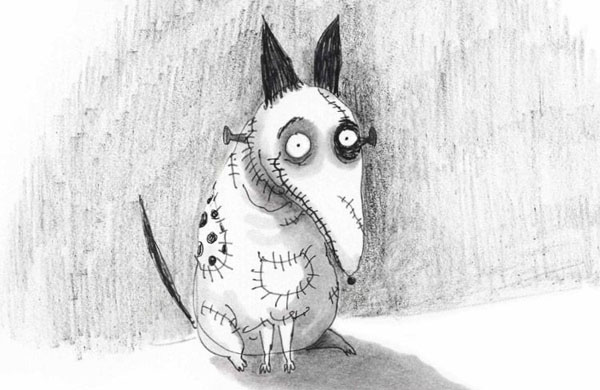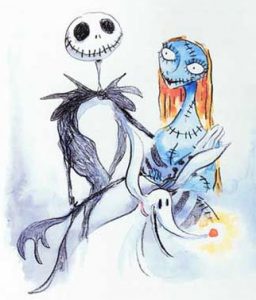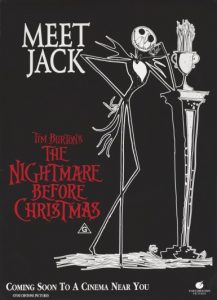
Suspended Animation #297
Tim Burton’s The Nightmare Before Christmas is both a great Halloween movie as well as a Christmas film but part of its inspiration came from the personal trauma that Burton himself was experiencing working at the Disney Studio.
Born in Burbank on August 25th, 1958, Timothy William Burton grew up near the Disney Studio and for him drawing was a sanctuary from his perceived horrors of everyday life and school.
“I came [to Disney] when I was 13, just to visit and ask what I would have to do to work here,” Burton recalled. “They told me the standard stuff about going to school. I hated school.”
Encouraged by his high school art teacher and wanting a career for which he wouldn’t need too much more schooling, Burton got an artistic scholarship to attend California Institute of the Arts in 1976 where he studied animation.
His final class project in 1979 was a short student hand-drawn animated film about a creepy dentist named Dr. Maxwell Payne and his assistant entitled Stalk of the Celery Monster. Looking for potential new talent with new ideas, Disney always reviewed the students’ final projects and liked Burton’s short. They offered him an apprenticeship job at the Disney Studio.
He was teamed with veteran animator Glen Keane to work on the animated feature The Fox and the Hound (1981).
“I couldn’t draw those four-legged Disney foxes. I just couldn’t do it. I couldn’t even fake the Disney style. Mine looked like roadkills,” Burton remembered.
Burton found himself assigned to drawing the distance shots where his lack of ability in the approved “Disney-style” of cute drawing would be less noticeable.
Burton became visibly depressed at work, demonstrating erratic behavior including sleeping in a closet, and he was teamed with another new animator Andreas Deja in the hopes that Deja might be able to make Burton’s unusual sketchy, angular artwork more “Disney-esque” for film.
They worked as concept artists for the fantasy animated feature The Black Cauldron (1985) where it was felt that Burton’s gothic sensibilities might be better utilized.

Tim Burton at Disney working on “Vincent”
“They were very nice to me,” Burton later said. “They said, ‘We’re doing this movie, The Black Cauldron’, so I just sat in a room for a year and came up with ideas and stuff, just drew any idea I wanted to, and it was great. It was like weird characters, weird props, weird furniture, just sitting in a room doing whatever I wanted. But at some point I realized they had no intention of using any of it.”
However, Burton’s work caught the attention of producer Julie Hickson and the head of creative development at Disney at the time, Tom Wilhite. They sensed that Burton’s originality might be worth exploring on non-traditional Disney projects.
It was Wilhite who got the funding to make the animated short Burton had written and would direct entitled Vincent (1982) about a boy who wanted to grow up to be the Vincent Price from his many Edgar Allen Poe-inspired horror films.
Disney liked the final five minute short that had been done in stop-motion rather than standard cel animation but had no idea what to do with it. It garnered several critical accolades when it played at film festivals in London, Chicago and Seattle, winning two awards in Chicago and the Critics’ Prize at the Annecy Film Festival in France.
In addition, Disney suggested changing the ending to be more upbeat with the previously unseen father showing up and taking little Vincent to a ball game and the boy becoming more “normal” as a result. Burton refused and the melancholy ending remained. An early version of the Jack Skellington character appears briefly in the upper-left corner of the screen from 1:18-1:25.
Burton’s next project was an odd and dark interpretation of Hansel and Gretel done with an all live-action Japanese cast that was shown only once on Halloween night 1983 on the Disney Channel and has never been re-issued. The set design and props certainly were distinctively Burton designs. Once again, Disney had no idea what to do with this half hour film.
Before he left Disney, Burton also directed a black-and-white live action short titled Frankenweenie (1984), a twist on the classic Frankenstein horror film, where a young boy brings his stitched-together dead dog, Sparky, back to life through electricity.
In 1982, Burton worked on another poem story like Vincent but this time about a Halloween land. It was three pages long and featured Jack Skellington, his ghost dog Zero who had a tiny glowing orange jack-o-lantern as a nose and Santa Claus. It was called The Nightmare Before Christmas as a take-off on the famous Christmas poem, A Visit from St. Nicholas — commonly known as The Night Before Christmas.
 Growing up in ever-sunny Burbank, Burton found that the usual visual seasonal changes elsewhere in the country like the changing color of leaves did not take place.
Growing up in ever-sunny Burbank, Burton found that the usual visual seasonal changes elsewhere in the country like the changing color of leaves did not take place.
He recalled that local merchants were so eager to increase sales that there was sometimes a melding of Halloween and Christmas decorations and advertisements in some stores to lengthen the shopping season.
As a result, in his mind, it seemed natural for Halloween to intrude on Christmas and become a combination of his two favorite holidays.
“I loved Halloween,” said Burton. “I wanted to do a story that would put (Halloween and Christmas) together. Somehow I thought of a Halloween Town to match the North Pole and took images and just sort of twisted them together.”
Animator Henry Selick first encountered Tim Burton and his The Nightmare Before Christmas project at this time and was supportive when Burton proposed it as a half hour television holiday special, perhaps narrated by Vincent Price. Burton also proposed it as a possible children’s book but again, Disney was uninterested.
“I took it around the networks, did storyboards and sketches and Rick Heinrichs did a little model of Jack,” said Burton. “Everybody said they liked it, but not enough to do it at that time. I guess that was my first real taste of show business mentality – a nice big smile and an ‘Oh, yeah, we’re going to do this’. But as you proceed it becomes less and less of a reality.
 “There was even some talk about doing it as a feature film but as drawn cel animation. But I didn’t want to do that. I decided to try to hide it away but always with that feeling that I would do it some time but do it right.”
“There was even some talk about doing it as a feature film but as drawn cel animation. But I didn’t want to do that. I decided to try to hide it away but always with that feeling that I would do it some time but do it right.”
Selick also left the studio around the same time as Burton. In 1984, Michael Eisner and Frank Wells had just been put in charge and the old regime that had tried to support Burton was gone.
Burton recalled, “By that point I was really tired of Disney. It was a case of doing a bunch of stuff that nobody would ever see. It was kind of weird. I was like the weird relative that they’d let out occasionally and then lock back up in my room.”
Luckily, also in 1984, actor Paul Reubens was looking for a director for a film idea he had been developing for many years called Pee-Wee’s Big Adventure based on a character he had been portraying in various live shows.
Reubens screened Frankenweenie and liked what he saw. He hired Burton which began a new career for the young animator that resulted in him directing four critically and financially successful live-action feature films in a row and eventually returning to Disney to produce a feature film of The Nightmare Before Christmas based on his story idea.


 Jim Korkis is an internationally respected animation historian who in recent years has devoted his attention to the many worlds of Disney. He was a columnist for a variety of animation magazines. With his former writing partner, John Cawley, he authored several animation related books including The Encyclopedia of Cartoon Superstars, How to Create Animation, Cartoon Confidential and Get Animated’s Animation Art Buyer’s Guide. He taught animation classes at the Disney Institute in Florida as well as instructing classes on acting and animation history for Disney Feature Animation: Florida.
Jim Korkis is an internationally respected animation historian who in recent years has devoted his attention to the many worlds of Disney. He was a columnist for a variety of animation magazines. With his former writing partner, John Cawley, he authored several animation related books including The Encyclopedia of Cartoon Superstars, How to Create Animation, Cartoon Confidential and Get Animated’s Animation Art Buyer’s Guide. He taught animation classes at the Disney Institute in Florida as well as instructing classes on acting and animation history for Disney Feature Animation: Florida.




















































All biographical sources I’ve seen give Burton’s middle name as Walter, not William.
I remember seeing “Pee-Wee’s Big Adventure” in 1985 and thinking that whoever directed it must be a genius. I think Burton proved me right, even though I don’t see eye-to-eye with his penchant for remaking classics like Willy Wonka and Planet of the Apes. Thanks for this look at his early work. I don’t know if Tim Burton will ever be named a Disney Legend, but there seems to be a spark of the old Disney magic running through his films.
Paul — Walter it is. But I didn’t come up with William in some type of fever dream. I got it from Encyclopaedia Britannica whose “editors oversee subject areas in which they have extensive knowledge, whether from years of experience gained by working on that content or via study for an advanced degree”. https://www.britannica.com/biography/Tim-Burton
But as always, always happy with any and all corrections. It is important to have accurate information in print. Thanks.
Don’t be too quick to discount the Encyclopaedia Britannica, Jim. As a rule I’m inclined to accept their word over that of Wikipedia and imdb.com, which are among the sources giving Tim Burton’s middle name as Walter. A quick look around on the Internet uncovered other websites that agree with Britannica. (Not that it proves anything, but Burton’s father and his son are both named William.) I just took a Tim Burton online trivia quiz (and received an excellent score thanks to having read your article), and the question about his middle name elicited the following e e cummings poem as a comment:
Anyone claiming to be Burton’s biggest fan, even if only semi-literate, would likely know his true middle name, and I have taken other online trivia quizzes that contained erroneous answers. So which is it? If someone takes the trouble to dig up his birth records, then we’ll all know for certain, but I don’t think it really matters much.